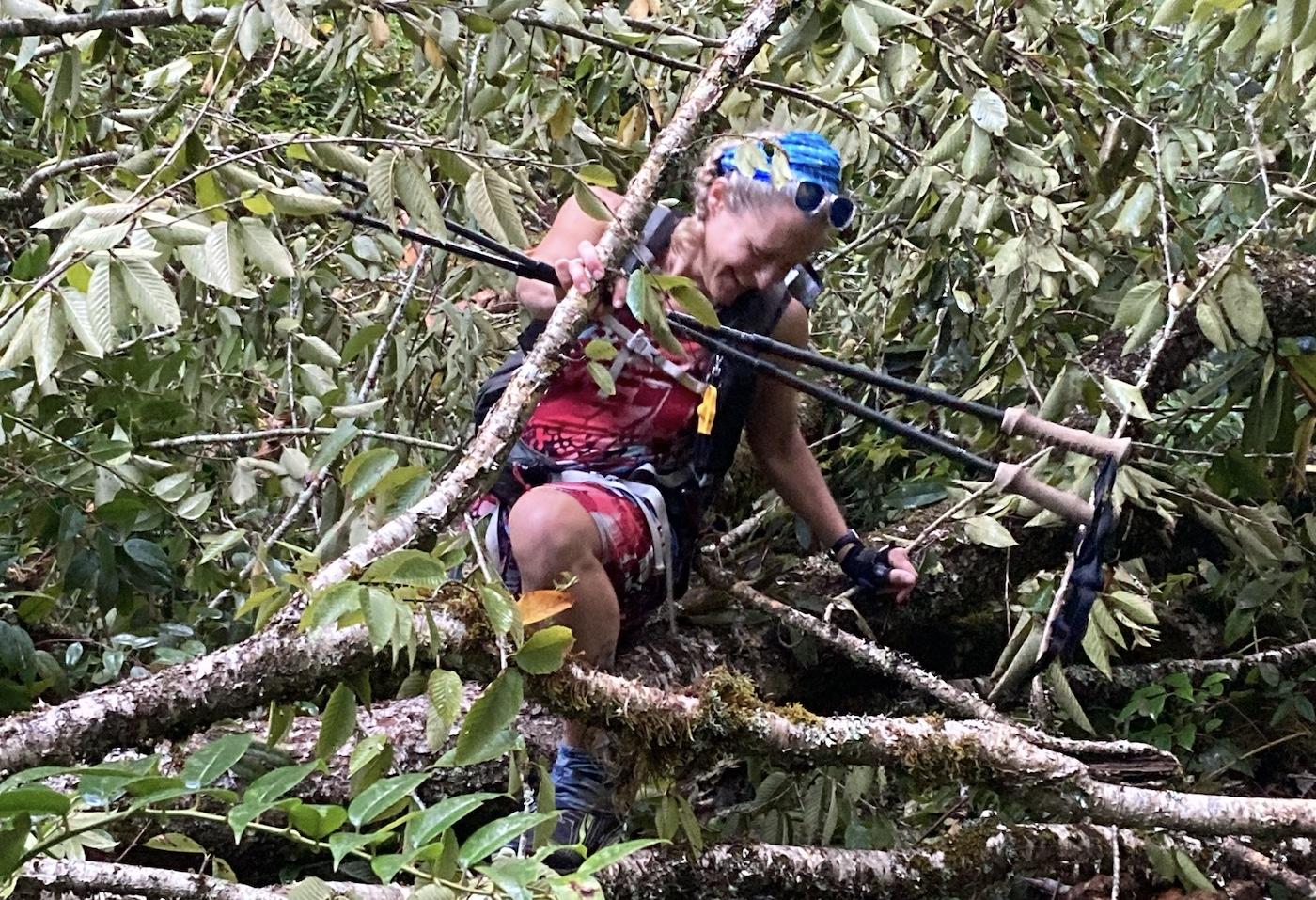
Nancy East navigating a blowdown on the Deep Creek Trail/Courtesy of Nancy East
On October 3, Nancy East (Seal Mom) and Christ Ford (Pacer) finished hiking all the trails in Great Smoky Mountains National Park in a record time - 29 days, 10 hours, and 12 minutes - that established a new Fastest Known Time (FKT) in the park. There are more than 800 miles of crisscrossing trails in the Smokies. East and Ford walked 947.9 miles; rounding up, that’s 31.6 miles per day.
Unlike a linear trail such as the Appalachian Trail, the Smokies trails are a web of intersecting trails. Much of the challenge is untangling this web to hike all the trails in an efficient manner.
By now, there are more than 670 people who have hiked all the trails in the Smokies, including me, and have become members of the Smokies 900M club. Many have completed several “maps,” which refers to walking all the trails in the Smokies.
But East and Ford have taken the 900M challenge to a whole new level. On a backpack trip, East, 48, discussed her desire to try for the FKT with her hiking companions. First Ford, a 52-year-old retired Air Force veteran, and East, 48, a retired veterinarian, came up with Le Tour de LeConte; hiking all six trails leading to Mount LeConte - 44 miles - within a 24-hour period. They accomplished this in 16 hours and 13 minutes. As part of this challenge, they raised more than $6,300 to benefit the Trails Forever program of Friends of the Smokies.
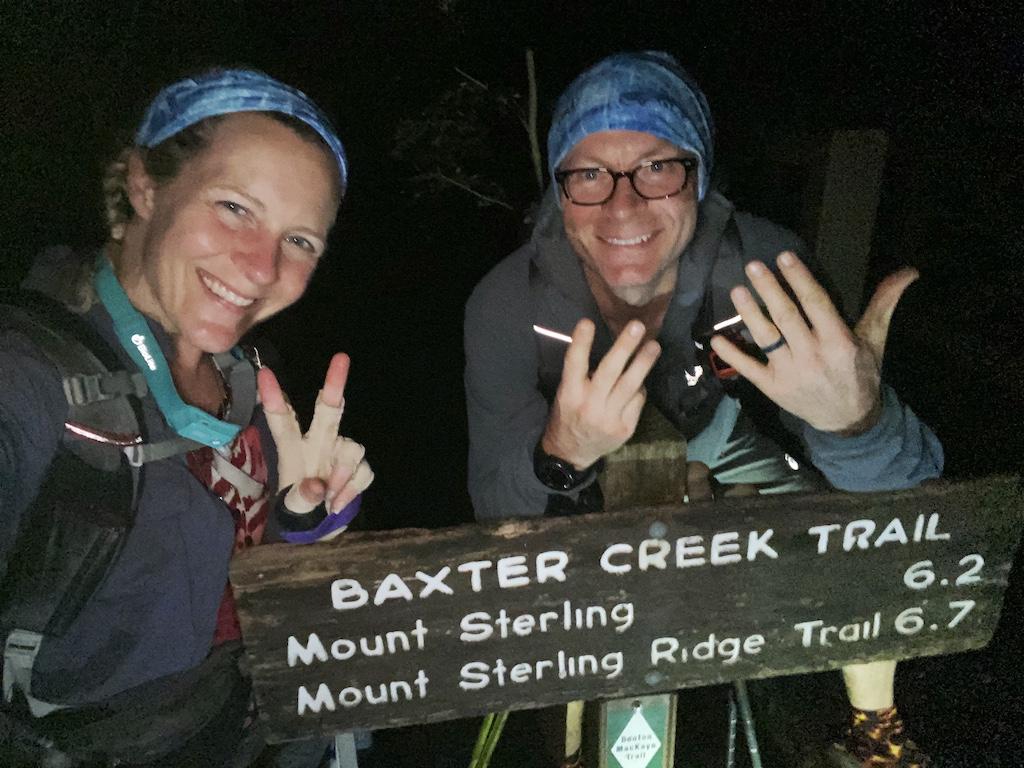
Nancy East and Chris Ford at the finish of their next to last day, holding up their fingers to indicate the 28th day of hiking/ Courtesy of Nancy East
The longer challenge was triggered by a sad event. East, a volunteer on the Haywood County (North Carolina) Search and Rescue, was involved in the search for Susan Clements in Great Smoky Mountains National Park in September 2018. When Clements was returning from a moderate hike to Andrews Bald, she must have gotten confused and lost her way going back to the Clingmans Dome parking lot.
East understood that she needed to promote hiker education in a way that grabs people’s attention. “I wanted to do more than write a check to the Preventive Search & Rescue Program in the Smokies,” East said.
The next challenge for East and Ford was to hike all the trails in the Smokies and break the Fastest Known Times (FKT). Ford suggested that they should attempt this in less than 30 days. This was a fortuitous decision that contributed to their success.
The 4-Minute Mile Effect
In 1954, Roger Bannister, a British athlete and neurologist, ran a mile barely under four minutes. At the time, the 4-minute mile seemed to be a psychological as well as a physical barrier. Only 46 days later, John Landy, an Australian runner, bested Bannister’s record. And now thousands of runners have done a 4-mile mile.
A record has to be set so it can be broken. When Sharon Spezia was 63, she finished her first map of the Smokies. Several years later, she walked all the trails in 4 months and 12 days by hiking a couple of times a week. She established a record, walked a second map in the same year and tickled the imagination of other Smokies hikers. Now 71, she’s working on her tenth map, dedicating each map and certificate to her seven grandchildren, and other family members.
“I am not as fast as the young ones, but I get the trails,” Spezia says.
Just like Bannister, Spezia showed that it could be done. Benny Braden, an electrical contractor from Knoxville, Tennessee, knew that he could do better. His first map took 78 days by hiking four days a week. “I beat her FKT record but it didn’t feel like an FKT.”
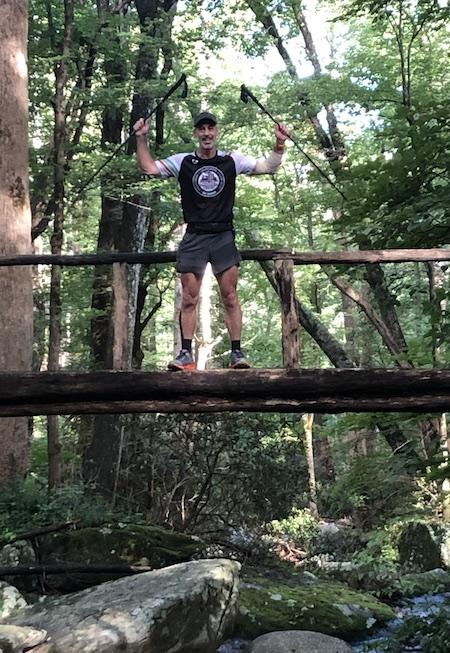
Jeff Woody, previous record holder, at the Woody House/Courtesy of Jeff Woody
In the fall 2017, Braden hiked every day and walked 924 miles in 43 days. He was supported in a minimal way. “People gave me a shuttle and I would leave the park once a week to get supplies,” Braden said.
Spezia and Braden are hikers. The next challenger, Jeff Woody, is a runner. A 56-year-old an engineering consultant at Oak Ridge National Laboratory, Woody was working from home during the pandemic and decided to go for the Smokies FKT. It was his ninth map and he really knows the park. He worked out the logistics on his own to minimize the number of miles repeated.
He ran about seven hours a day. Then he went home and worked, answering phone calls and holding meetings. His wife was his only support team. He finished in 33 days 9 hours running 950 miles.
“I knew the record would be broken at some point,” Woody says. “I have much respect for what Nancy and Chris did. They walked 14 to 15 hours every day. Hats off to them.”
There's Linear, And Then There's Convoluted
Most FKTs are associated with linear trails such as the A.T. Earl V. Shaffer (1918 – 2002),walked the A.T. in 1948 from Mount Oglethorpe, in Georgia (the trail's southern end at that time to Mount Katahdin in Maine) in 124 days, averaging 17 miles per day and becoming the first person to hike the whole trail in one season. Many critics and naysayers doubted his feat, saying that this was impossible.
The FKT for the A.T. now belongs to Belgian ultrarunner and dentist Karel Sabbe who ran the 2,190 miles in 41 days, 7 hours, and 39 minutes. Like most but not all A.T. record holders, Sabbe was supported by a small crew that provided food and other logistical help.
FKTs can be done in three ways: unsupported, self-supported and full support. For supported feats, a crew provides food, water, food, and any supplies along the way. Typically the crew sets up camp and cooks so the hiker can just flop into a sleeping bag. A self-supported attempt is most similar to a traditional thru-hike. There’s no outside crew but the hiker can stash supplies along the route prior to the attempt – and presumably get rides into town. A completely unsupported effort means that hikers has to carry all their own supplies and just collect water along the way. The Fastest Known Time website records all these attempts.
Is this a Smokies phenomenon?
Shenandoah National Park in Virginia has the same general terrain and seasonal conditions as the Smokies. The Shenandoah 500 miles club (SNP 500) was created in 2014, about 20 years after the Smokies 900M challenge. Like most such challenges, a hiker has a lifetime to finish all the trails in the park.
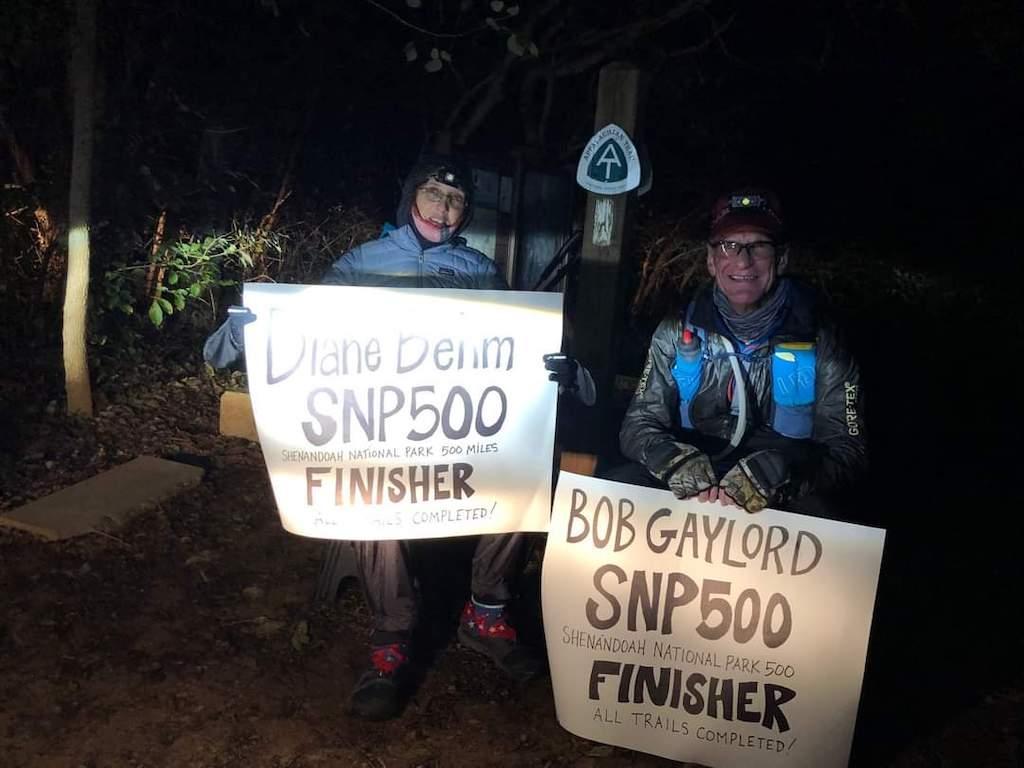
Diane Behm and Robert Gaylord finishing the SHEN500M – Courtesy of Diane Behm
Diane Behm established a record in 2018 by finishing the SNP500 in under 10 months, with an accumulated mileage of 730 miles. Her final push was the 105 miles of A.T. in 46.5 hours.
“I preplanned all the routes ahead of time so I would have the most minimal overlap, which is also why I also decided to do the A.T. last all in one go. You also have to account for closures of Skyline and always have a backup route. I kept the mileage to average 23 miles each time I went out there,” Behm said.
Behm and her hiking partner, Robert Gaylord, have not yet been beaten. “No other attempts have been made yet, but I have had an ultra-runner interested who has asked me some questions,” Behm says.
While East and Ford were hiking in the Smokies, Tara Dower set the Fastest Known Time on the Mountains-to-Sea Trail across North Carolina. The route starts in Clingmans Dome in the Smokies, includes hundreds of miles through the Blue Ridge Parkway and ends on the Outer Banks just outside Cape Hatteras National Seashore. The entire 1,175-mile journey took 29 days, 8 hours, and 48 minutes. Dower said she started her days at 3 a.m., putting in more than 40 miles most days.
The search for FKTs in national parks has not landed other candidates. In Rocky Mountain National Park, Barb Trufholtz took 40 years to hike the 355 miles of trails.
Logistics In The Smokies
What makes East's and Ford’s FKT fascinating is that they had a trail boss. Lane DeCost worked out a day-by-day route for the hikers. How does one walk all the trails with a minimum of repetition? DeCost, a retired investment manager who has also hiked all the trails in the Smokies, is a teammate of Nancy East’s search and rescue group. DeCost loves logistical problems. His guiding principles for East and Ford were efficiency and balance.
Efficiency: Minimize duplicate segments, do the big elevation gain in the morning, and end every day at an accessible trailhead to facilitate shuttles. Balance: Keep the mileage between 28 to 34 miles and mix easy, moderate, and difficult days to allow for recovery.
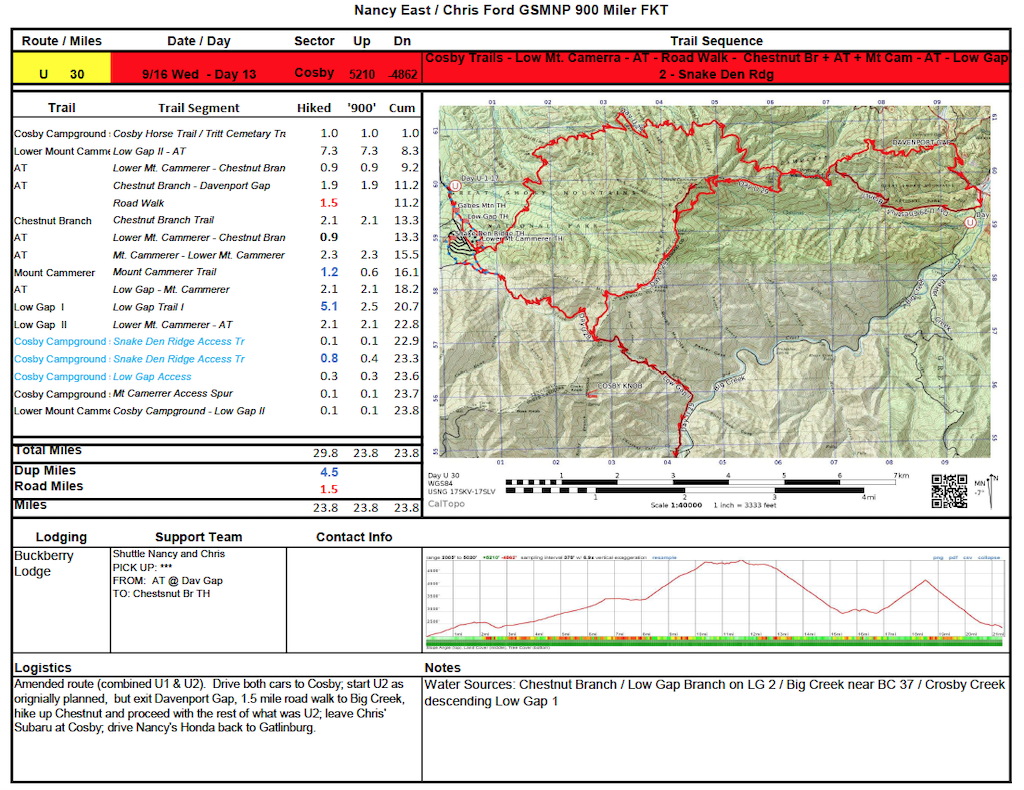
Daily hiking sheet, for Day 13, for Nancy East and Chris Ford/Courtesy of Lane DeCost
East calculated that their average pace on the trail was 2.72 miles per hour. Allowing for breaks for water filtering, comfort stops, and talking to people, it dropped to 2.6 miles per hour. “People mistakenly think we’re super-fast hikers. While we’re both capable of hiking a faster pace, slow and steady won this one,” East says.
Ford and East work and hike well together. “We’re so blessed to have spouses that understand,” Ford points out. “We’re both married to our high school sweetheart and there’s a lot of trust.”
After East finished, she took her three children, all going to school online, to a North Carolina beach for a week. The second week, East hit an emotional and physical slump; she was just tired. She slowed down and went to bed early for a few days.
“We so appreciate the amazing 900 Mile Challenge accomplished by Nancy East and Chris Ford in raising support for GSMNP Search and Rescue program,” said Tim Chandler, executive director of Friends of the Smokies. "The money they raised helped purchase a new Dodge truck for the search-and-rescue teams and additional supplies. Chris and Nancy were honored guests for the ribbon cutting and opening of Trillium Gap on November 10 with the Trails Forever program."



Comments
Fantastic! Congratulations for the achievement. Great to have Lane's mind and wisdom to help.
Great article. Thank you Danny - this is a great explainer of how an FKT works and what that looks like at a variety of national parks/public lands.
Thank you for covering our FKT journey and highlighting the associated fundraiser for Friends of the Smokies! Great article on the history of the FKT in the Smokies and beyond!